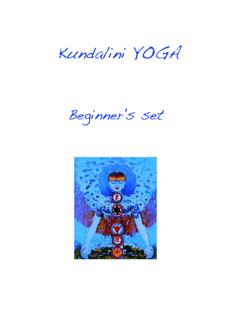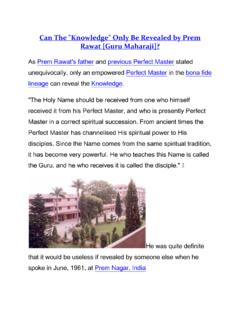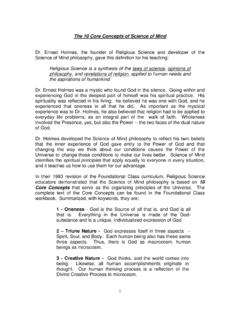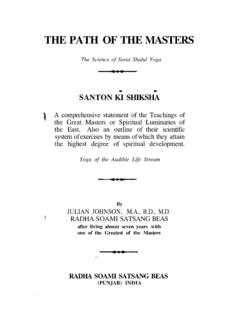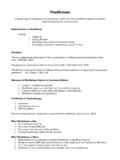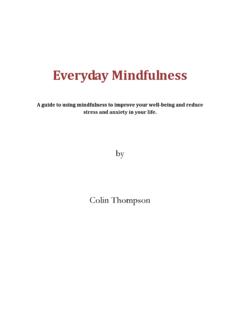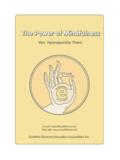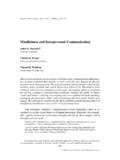Transcription of The Foundations of Mindfulness - …
1 The Foundations of Mindfulness Satipa h na Sutta Translated by Nyanasatta Thera Buddhist Publication Society Kandy, Sri Lanka The Wheel Publication No: 19. Copyright Kandy; Buddhist Publication Society, (1993). BPS Online Edition (2006). Digital Transcription Source: Buddhist Publication Society For free distribution. This work may be republished, reformatted, reprinted and redistributed in any medium. However, any such republication and redistribution is to be made available to the public on a free and unrestricted basis and translations and other derivative works are to be clearly marked as such. Contents The Foundations of Introduction The philosophy of Buddhism is contained in the Four Noble Truths 1. The truth of suffering reveals that all forms of becoming, all the various elements of existence comprised in the five aggregates or groups of existence also called the five categories which are the objects of clinging (pa cupad nakkhandh ) are inseparable from suffering as long as they remain objects of grasping or clinging.
2 All corporeality, all feelings and sensations, all perceptions, all mental formations and consciousness, being impermanent, are a source of suffering, are conditioned phenomena and hence not-self (anicca, dukkha, anatt ). Ceaseless origination and dissolution best characterize the process of existence called life, for all elements of this flux of becoming continually arise from conditions created by us and then pass away, giving rise to new elements of being according to one's actions or kamma. All suffering originates from craving, and our very existence is conditioned by craving, which is threefold: the craving for sense pleasures (k ma-ta h ), craving for continued and renewed existence (bhava-ta h ), and craving for annihilation after death (vibhava-ta h ). This is the truth of the origin of suffering. The attainment of perfect happiness, the breaking of the chain of rebirths and suffering through the realization of Nibb na, is possible only through the utter extirpation of that threefold craving.
3 This is the truth of suffering's cessation. The methods of training for the liberation from all suffering are applied by following the Noble Eightfold Path of Right Understanding, Right Thought, Right Speech, Right Action, Right Living, Right Exertion, Right Mindfulness and Right Concentration of Mind. The Noble Eightfold Path consists of three types of training summed up in: virtuous conduct (s la), concentration (sam dhi) and wisdom (pa a). This is the truth of the way that leads to the cessation of suffering. The prevalence of suffering and absence of freedom and happiness is due to man's subjection to the three roots of all unskill and evil, and all unwholesome actions (akusalakamma), viz. lust, hatred and delusion (lobha, dosa, moha). Virtuous conduct casts out lust. The calm of true concentration and mental culture conquers hatred. Wisdom or right understanding, also called direct knowledge resulting from meditation, dispels all delusion.
4 All these three types of training are possible only through the cultivation of constant Mindfulness (sati), which forms the seventh link of the Noble Eightfold Path. Mindfulness is called a controlling faculty (indriya) and a spiritual power (bala), and is also the first of the seven factors of enlightenment (satta bojjha ga).2 Right Mindfulness (samma-sati) has to be present in every skillful or karmically wholesome thought moment (kusalacitta). It is the basis of all earnest endeavour (appam da) for liberation, and maintains in us the sense of urgency to strive for enlightenment or Nibb na. The Discourse on the Foundations of Mindfulness , the Satipa h na Sutta, is the tenth discourse of the Middle Length Collection (Majjhima Nik ya) of the Discourses of the 1. An exhaustive exposition of the Four Noble Truths is found in The Word of the Buddha by Nyanatiloka Mah thera. See also Three Cardinal Discourses of the Buddha, translated by amoli Thera (BPS Wheel No.)
5 17) and The Four Noble Truths by Francis Story (BPS Wheel No. 34/35). 2. See Piyadassi Thera, The Seven Factors of Enlightenment (BPS Wheel No. 1). 2. Enlightened One. It is this version which is translated in the present publication. There is another version of it, in the Collection of Long Discourses (D gha Nik ya ), which differs only by a detailed explanation of the Four Noble Truths. The great importance of the Discourse on Mindfulness has never been lost to the Buddhists of the Theravada tradition. In Sri Lanka, even when the knowledge and practice of the Dhamma was at its lowest ebb through centuries of foreign domination, the Sinhala Buddhists never forgot the Satipa h na Sutta. Memorizing the Sutta has been an unfailing practice among the Buddhists, and even today in Sri Lanka there are large numbers who can recite the Sutta from memory. It is a common sight to see on full-moon days devotees who are observing the Eight Precepts, engaged in community recital of the Sutta.
6 Buddhists are intent on hearing this Discourse even in the last moments of their lives; and at the bedside of a dying Buddhist either monks or laymen recite this venerated text. In the private shrine room of a Buddhist home, the book of the Satipa h na Sutta is displayed prominently as an object of reverence. Monastery libraries of palm-leaf manuscripts have the Sutta bound in highly ornamented covers. One such book with this Discourse written in Sinhala script on palm-leaf, has found its way from Sri Lanka as far as the State University Library of Bucharest in Rumania. This was disclosed while collecting material for the Encyclopaedia of Buddhism, when an Esperantist correspondent gave us a list of a hundred books on Buddhism found in the Rumanian University Libraries. Mindfulness of Breathing ( n p nasati). The subjects dealt with in the Satipa h na Sutta are corporeality, feeling, mind and mind objects, being the universe of right Buddhist contemplation for deliverance.
7 A very prominent place in the Discourse is occupied by the discussion on Mindfulness of breathing ( n p nasati). To make the present publication of greater practical value to the reader, an introductory exposition of the methods of practicing that particular meditation will now be given. Mindfulness of breathing takes the highest place among the various subjects of Buddhist meditation. It has been recommended and praised by the Enlightened One thus: This concentration through Mindfulness of breathing, when developed and practiced much, is both peaceful and sublime, it is an unadulterated blissful abiding, and it banishes at once and stills evil unprofitable thoughts as soon as they arise. Though of such a high order, the initial stages of this meditation are well within the reach of a beginner though he be only a lay student of the Buddha-Dhamma. Both in the Discourse here translated, and in the 118 th Discourse of the same Collection (the Majjhima Nik ya), which specifically deals with that meditation, the initial instructions for the practice are clearly laid down: Herein, monks, a monk, having gone to the forest or the root of a tree or to an empty place, sits down with his legs crossed, keeps his body erect and his Mindfulness alert.
8 Ever mindful he breathes in, mindful he breathes out. Breathing in a long breath, he knows, I am breathing in a long breath ; breathing out a long breath, he knows, I am breathing out a long breath.. Breathing in a short breath, he knows, I am breathing in a short breath ; breathing out a short breath, he knows, I am breathing out a short breath. Experiencing the whole (breath) body, I. shall breathe in, thus he trains himself. Experiencing the whole (breath-) body, I shall breathe out, thus he trains himself. Calming the activity of the (breath-) body, I shall breathe in, thus he trains himself. Calming the activity of the (breath-) body, I shall breathe out, thus he trains himself. 3. These are instructions given by the Enlightened One to the monks who, after their alms round, had the whole remaining day free for meditation. But what about the lay Buddhist who has a limited time to devote to this practice?
9 Among the places described as fit for the practice of meditation, one is available to all: su agara, lit. empty house, may mean any room in the house that has no occupant at that moment, and one may in the course of the twenty-four hours of the day find a room in one's house that is empty and undisturbed. Those who work all day and feel too tired in the evening for meditation may devote the early hours of the morning to the practice of Mindfulness of breathing. The other problem is the right posture for meditation. The full lotus posture of the yogi, the padmasana, as we see it in the Buddha statues, proves nowadays rather difficult to many, even to easterners. A youthful meditator, however, or even a middle-aged one, can well train himself in that posture in stages. He may, for instance, start with sitting on a low, broad chair or bed, bending only one leg and resting the other on the floor; and so, in gradual approximation, he may finally master that posture.
10 There are also other easier postures of sitting with legs bent, for instance the half-lotus posture. It will be worth one's effort to train oneself in such postures; but if one finds them difficult and uncomfortable at the outset it will not be advisable to delay or disturb one's start with meditation proper on that account. One may allow a special time for sitting-practice, using it as best as one can for contemplation and reflection; but for the time being, the practice of meditation aiming at higher degrees of concentration may better be done in a posture that is comfortable. One may sit on a straight backed chair of a height that allows the legs to rest comfortably on the floor without strain. As soon however, as a cross-legged posture has become more comfortable, one should assume it for the practice of Mindfulness of breathing, since it will allow one to sit in meditation for a longer time than is possible on a chair.
